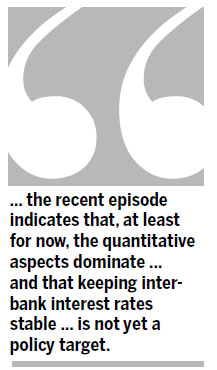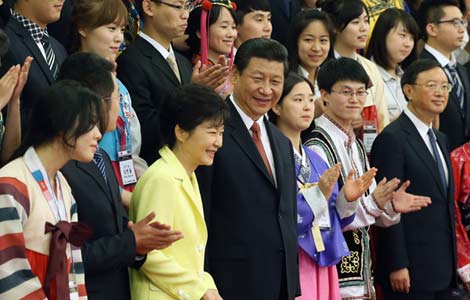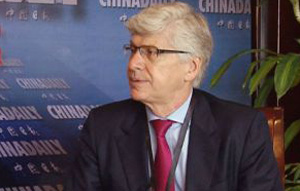After the liquidity crunch
Updated: 2013-06-28 08:07
By Louis Kuijs (China Daily)
|
||||||||

The standoff between the People's Bank of China and China's banks, and the resulting "liquidity crunch", has far-reaching implications for credit and liquidity, financial stability, monetary policy and the economic outlook. The potential for broad impact was underscored when the stock market witnessed a "black Monday" on June 24 partly because a June 23 statement of the PBOC suggested a continued hard-line stance, before some relief was provided by a more accommodating June 25 statement.
The liquidity crunch on the inter-bank market largely resulted from a misunderstanding between the markets and the PBOC about the central bank's policy and implementation.
The misunderstanding arose because concerns among some policymakers about too rapid credit growth and financial risks, suggested a need for tighter policy at the same time as lower economic growth called for easier policy. Given the tighter conditions and remaining uncertainty, the inter-bank market is likely to remain tight and nervous in the coming weeks, with repayment risk being sizeable. Even though the inter-bank market should normalize gradually after that, the banks will probably become more prudent with lending and liquidity going forward, and "non-bank" lending activity and mid-sized banks reliant on wholesale funding are likely to be especially affected.
We may well see some defaults on inter-bank loans and/or other repayment obligations in the coming months, although it remains highly unlikely that pressures stemming from financial risks would become systemic enough to threaten China's financial stability or the overall economy.
On the growth front, the firmer policy stance in the face of weak data has increased downside risks to our economic growth forecast. In spite of weak recent activity data, the government and the PBOC have signaled that for now they do not want to ease the macro stance, in effect putting considerations of medium-term financial stability ahead of supporting short-term economic growth.
Their resolve may be tested in the coming months if activity data continue to disappoint. We keep our forecast of 7.5 percent GDP growth in 2013 for now, acknowledging the downside risks but also noting some possibly positive news about the US economy.
Since June 13, inter-bank market interest rates rose to uncommonly high levels as liquidity conditions on the inter-bank market tightened. While they have recently come down they are still higher than normal. Several specific factors contributed to the tightness, including a change in timing of corporate tax payments, strong liquidity demand around the national holiday (Dragon Boat Festival) and the impact of measures taken in May to clamp down on financial capital inflows. The turbulence in international capital markets after indications of possible QE3 (third round of quantitative easing) tapering in the US added uncertainty, even though fundamentally China is not really vulnerable to this shifting flow.
Despite these factors affecting liquidity, China's banks apparently extended credit quite aggressively at the beginning of June. They might have assumed that the PBOC would accommodate this by injecting more liquidity in the inter-bank market, given the sluggish economic growth and calls for an easing of the macroeconomic stance. However, it turned out that the PBOC did not want to be accommodative. It seems that the PBOC wants to stick to its existing quantitative targets, and have the banks stick to their credit quotas and contain expansion of the "non-bank" financial sector. As a result, the PBOC has initially abstained from providing more liquidity.
As happened in the developed countries during the global financial crisis, amid the resulting uncertainty and confusion China's largest banks - which mostly tend to be net suppliers on the inter-bank market - appear to have held on more closely to their cash, accentuating the increase in interest rates.
What are the implications?
This episode has shown that the PBOC is serious about containing monetary aggregates and does not want to accommodate banks' attempts to test its policy stance. We think the PBOC's stance is in line with the government's overall stance, with senior leaders exhibiting little appetite for an easier macro stance. In fact, a statement issued after a meeting of the State Council, China's cabinet, on June 19 seemed to support the PBOC's stance. The statement called for "prudent monetary policy" and a "reasonable scale of monetary aggregates".
A June 23 statement of the PBOC after the monetary policy committee's quarterly meeting did not provide much relief. It reiterated the State Council's call last week for "prudent monetary policy and a "reasonable scale" of monetary aggregates. While it referred to the need to "fine-tune" monetary policy it made no explicit reference to the liquidity crunch or initiatives to alleviate it. Relief did come after the PBOC in a June 25 statement committed to ensuring sufficient overall liquidity and offering temporary liquidity to invidual banks if necessary.
The tighter financial conditions will affect the non-bank ("shadow banking") sphere, the less well-regulated part of the financial sector where lending has been rising rapidly recently and risks have built up. Indeed, containing non-bank lending and the associated risks seems to have been a key consideration in the firming up of the monetary stance.
Parts of the non-bank financial system may be particularly sensitive to tighter monetary conditions and regulation, and repayment risk in this sphere has increased. This is true in the case of banks (and other players) that relied on funding from the inter-bank market to fund investments in higher yielding securities or other investments or those that relied on funding from the inter-bank market to meet repayment obligations on wealth management products.
Thus, some default-type problems in this sphere are possible in the coming weeks, although we do not think the financial risks emanating from the non-bank financial system are large and systemic enough to overwhelm macroeconomic and financial stability in China.
This episode underscores issues with the current monetary policy framework. One key issue is the need for the authorities to communicate the policy stance more clearly and avoid, if possible, abrupt changes in the stance. While observers and some policymakers had raised concerns about non-bank credit in recent months, comments made by PBOC officials until recently appeared to be relatively sympathetic to non-bank lending and did not obviously signal an upcoming firming up of the stance.
Also, this episode suggests further steps in reform of the monetary policy framework may take time. The government would in principle like to adjust the monetary policy regime toward a larger role for the interest rate, away from the traditional emphasis on quantities. It had made progress in this area, including by relying more on open market operations for liquidity management rather than changes in reserve requirement ratios, and until recently inter-bank interest rate behavior had become smoother.
But the recent episode indicates that, at least for now, the quantitative aspects dominate in the end and that keeping inter-bank interest rates stable - a key element of an interest-based monetary policy - is not yet a policy target.
The author is the chief China economist at the Royal Bank of Scotland in Hong Kong.
(China Daily USA 06/28/2013 page16)

 NASA telescope to probe solar mystery
NASA telescope to probe solar mystery
 Visit aids 'trust-building process'
Visit aids 'trust-building process'
 King of Pop returns
King of Pop returns
 Crowds cheer Court decision on gay marriage
Crowds cheer Court decision on gay marriage
 Hiring index signals further job weakness
Hiring index signals further job weakness
 Dance becomes popular stress relief
Dance becomes popular stress relief
 Philippine, US start Naval exercise in S China Sea
Philippine, US start Naval exercise in S China Sea
 Supreme Court gay rights ruling celebrated across US
Supreme Court gay rights ruling celebrated across US
Most Viewed
Editor's Picks

|

|

|

|

|

|
Today's Top News
Senate OKs immigration reform; hurdles remain
Snowden could request asylum in Russia: official
US collects Internet data on citizens
Boston bombing suspect accused in 4 deaths
816 elected in provincial leadership reshuffle
US adds to DPRK sanctions list
Chinese pros put trust in blogs
More Americans see Snowden as patriot: Poll
US Weekly

|

|






